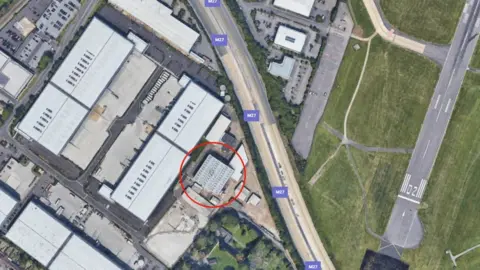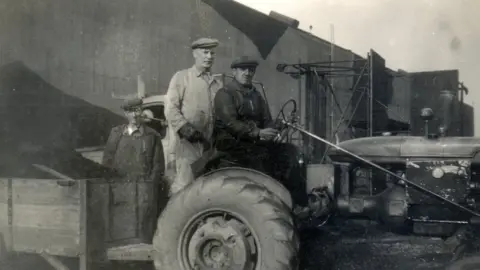Southampton Spitfire testing shed: Calls to save building from demolition
 Google
GooglePlans to demolish a "unique" building used to test wartime Spitfires should be halted, campaigners have said.
The Flight Shed on an industrial site near Southampton Airport, was later used by the Ford Transit factory.
As part of a redevelopment plan, its owners said it had "low significance".
The Spitfire Makers Charitable Trust called it "the single most important site associated with the Spitfire anywhere in the world".
After the main Supermarine factory in Southampton was bombed during World War Two, production was moved to smaller factories and workshops across the city and beyond.
The building, near Wide Lane, was used for final checking of completed Spitfires before they were delivered to the RAF.
It survived the war and was used as a tool room and paint shop for the Ford Transit factory in the 1970s.
The area has been earmarked for redevelopment following the closure of Ford's plant in 2013.
 Alan Matlock
Alan MatlockAlan Matlock, of the Spitfire Makers Charitable Trust - which is campaigning for 40 production sites in Southampton to be recognised with blue plaques, said almost all Spitfires that fought in the Battle of Britain would have passed through the Flight Shed.
He said: "It is the only surviving building that has an association with almost every Spitfire built in Southampton from the very first to the very last. It is unique.
"The pilots and the planes got the accolades but many people made it possible for them to take to the skies, and we want them to be commemorated.
"There is a growing outcry that demolishing this building could even be possible."
A heritage assessment for the planning application by Tungsten Properties said the Flight Shed building had "undergone extensive alterations" since being used by Ford.
"The building is considered to represent a non-designated heritage asset of lower significance, which will be removed as a result of the proposed development," it added.
Southampton City Council said the building was privately owned and non-listed.
If demolition was approved, it said a "full recording and photographic catalogue" for the city archive beforehand.
"Further evidence to help ascertain the significance of the building in heritage terms is being sought. As the hangar is on private land, thus it is not owned by the council, efforts to preserve or move it would be at the discretion of the owner," it added.

The Supermarine Spitfire
 Press Association
Press Association- The Spitfire was designed by Reginald Mitchell at the Supermarine factory in Woolston, Southampton
- The prototype was first flown from Eastleigh Aerodrome, now Southampton Airport, on 6 March 1936
- After Mitchell died in 1937, his successor Joe Smith developed the fighter to make it faster and more powerful
- The aircraft entered service in 1938 with the RAF, which initially ordered 310 of them from the Woolston works
- The site was bombed in 1940 at a time when most Spitfire manufacturing was being switched to a more modern production line at Castle Bromwich, near Birmingham
- Spitfires shot down a total of 529 enemy aircraft, for a loss of 230 of their own

Follow BBC South on Facebook, Twitter, or Instagram. Send your story ideas to [email protected].
